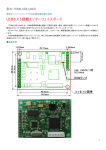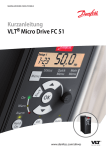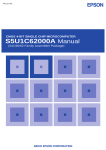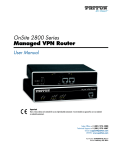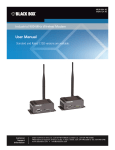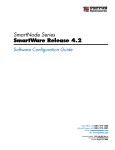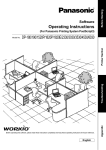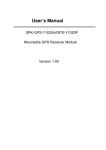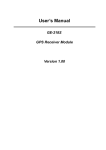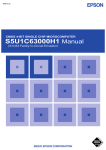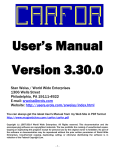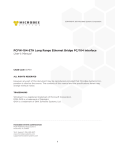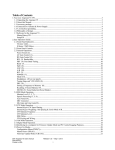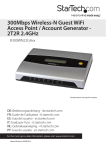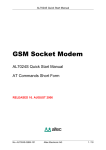Download DataHopper 900STN User Manual
Transcript
Operating Manual DataHopper 900 STN 900 MHz Spread Spectrum Radio Transceiver Revision 1.00, June 16, 2005 Warranty American Technologies warrants that each product will be free of defects in material and workmanship for a period of one (1) year for its products. The warranty commences on the date the product is shipped by American Technologies American Technologies sole liability and responsibility under this warranty is to repair or replace any product which is returned to it by the Buyer and which American Technologies determines does not conform to the warranty. Product returned to American Technologies for warranty service will be shipped to American Technologies at Buyer’s expense and will be returned to Buyer at American Technologies expense. In no event shall American Technologies be responsible under this warranty for any defect which is caused by negligence, misuse or mistreatment of a product or for any unit which has been altered or modified in any way. The warranty of replacement shall terminate with the warranty of the product. Warranty Disclaims American Technologies makes no warranties of any nature of kind, expressed or implied, with respect to the hardware, software, and/or products and hereby disclaims any and all such warranties, including but not limited to warranty of non-infringement, implied warranties of merchantability for a particular purpose, any interruption or loss of the hardware, software, and/or product, any delay in providing the hardware, software, and/or product or correcting any defect in the hardware, software, and/or product, or any other warranty. The Purchaser represents and warrants that American Technologies has not made any such warranties to the Purchaser or its agents AMERICAN TECHNOLOGIES EXPRESS WARRANTY TO BUYER CONSTITUTES AMERICAN TECHNOLOGIES SOLE LIABILITY AND THE BUYER’S SOLE REMEDIES. EXCEPT AS THUS PROVIDED, AMERICAN TECHNOLOGIES DISCLAIMS ALL WARRANTIES, EXPRESS OR IMPLIED, INCLUDING ANY WARRANTY OF MERCHANTABILITY OR FITNESS FOR A PARTICULAR PROMISE. Indemnification The Purchaser shall indemnify American Technologies and its respective directors, officers, employees, successors and assigns including any subsidiaries, related corporations, or affiliates, shall be released and discharged from any and all manner of action, causes of action, liability, losses, damages, suits, dues, sums of money, expenses (including legal fees), general damages, special damages, including without limitation, claims for personal injuries, death or property damage related to the products sold hereunder, costs and demands of every and any kind and nature whatsoever at law. IN NO EVENT WILL AMERICAN TECHNOLOGIES BE LIABLE FOR ANY INDIRECT, SPECIAL, CONSEQUENTIAL, INCIDENTAL, BUSINESS INTERRUPTION, CATASTROPHIC, PUNITIVE OR OTHER DAMAGES WHICH MAY BE CLAIMED TO ARISE IN CONNECTION WITH THE HARDWARE, REGARDLESS OF THE LEGAL THEORY BEHIND SUCH CLAIMS, WHETHER IN TORT, CONTRACT OR UNDER ANY APPLICABLE STATUTORY OR REGULATORY LAWS, RULES, REGULATIONS, EXECUTIVE OR ADMINISTRATIVE ORDERS OR DECLARATIONS OR OTHERWISE, EVEN IF AMERICAN TECHNOLOGIES HAS BEEN ADVISED OR OTHERWISE HAS KNOWLEDGE OF THE POSSIBILITY OF SUCH DAMAGES AND TAKES NO ACTION TO PREVENT OR MINIMIZE SUCH DAMAGES. IN THE EVENT THAT REGARDLESS OF THE WARRANTY DISCLAIMERS AND HOLD HARMLESS PROVISIONS INCLUDED ABOVE AMERICAN TECHNOLOGIES IS SOMEHOW HELD LIABLE OR RESPONSIBLE FOR ANY DAMAGE OR INJURY, AMERICAN TECHNOLOGIES'S LIABILITY FOR ANYDAMAGES SHALL NOT EXCEED THE PROFIT REALIZED BY AMERICAN TECHNOLOGIES ON THE SALE OR PROVISION OF THE HARDWARE TO THE CUSTOMER. Proprietary Rights The Buyer hereby acknowledges that American Technologies has a proprietary interest and intellectual property rights in the Hardware, Software and/or Products. The Purchaser shall not (i) remove any copyright, trade secret, trademark or other evidence of American Technologies ownership or proprietary interest or confidentiality other proprietary notices contained on, or in, the Hardware, Software or Products, (ii) reproduce or modify any Hardware, Software or Products or make any copies thereof, (iii) reverse assemble, reverse engineer or decompile any Software or copy thereof in whole or in part, (iv) sell, transfer or otherwise make available to others the Hardware, Software, or Products or documentation thereof or any copy thereof, except in accordance with this Agreement. ii DataHopper 900 Operating Manual DataHopper 900 900 MHz Spread-Spectrum Industrial Ethernet Bridge WARNING In order to comply with the FCC/IC adopted RF exposure requirements, this transmitter system will be installed by the manufacturer's reseller professional. Installation of all antennas must be performed in a manner that will provide at least 20 cm clearance from the front radiating aperture, to any user or member of the public. This manual contains information of proprietary interest to American Technologies. It has been supplied in confidence to purchasers and users of the DataHopper 900, and by accepting this material the recipient agrees that the contents will not be copied or reproduced, in whole or in part, without prior written consent of American Technologies American Technologies has made every effort to assure that this document is accurate and complete. However, the company reserves the right to make changes or enhancements to the manual and/or the product described herein at any time and without notice. Furthermore, American Technologies assumes no liability resulting from any omissions in this document, or out of the application or use of the device described herein. American Technologies products are appropriate are not authorized for utilization in applications where failure could result in damage to property or human injury or loss of life. The electronic equipment described in this manual generates, uses, and radiates radio frequency energy. Operation of this equipment in a residential area may cause radio interference, in which case the user, at his own expense, will be required to take whatever measures necessary to correct the interference. FCC Declaration of Conformity This device complies with Part 15 of the FCC Rules. Operation is subject to the following two conditions: (1) this device may not cause harmful interference, and (2) this device must accept any interference received including interference that may caused undesired operation. This Device Complies with Industry Canada RSS210 1573 North Main Street. Fall River, Ma 02720 Phone: (508) 672-0125 Fax: (508) 672-0254 © 2005 by American Technologies, All Rights Reserved. HyperTerminal is copyrighted by Hilgraeve Inc, and developed for Microsoft. Microsoft and Windows are registered trademarks of Microsoft Corporation. pcANYWHERE and Symantec are registered trademarks of Symantec Corp. All other products mentioned in this document are trademarks or registered trademarks of their respective holders. Manual Revision 1.00, June 16, 2005. iii DataHopper 900 Operating Manual Contents 1. A. B. C. D. E. F. G. H. Introduction 1.0 Product Overview .................................................................................................................................................................................... 1 1.1 Features.................................................................................................................................................................................................... 1 1.2 About this Manual ................................................................................................................................................................................... 2 Electrical/Physical 2.1 Connectors and Indicators ....................................................................................................................................................................... 3 2.2 RSSI (Received Signal Strength Indicators) ............................................................................................................................................ 5 2.3 DC Characteristics................................................................................................................................................................................... 5 2.4 AC Characteristics.................................................................................................................................................................................... 6 Modes of Operation ............................................................................................................................................................................................. 7 3.1 Data Mode ................................................................................................................................................................................................ 7 3.2 MODBUS Mode....................................................................................................................................................................................... 8 3.3 Command Mode ....................................................................................................................................................................................... 8 3.3.1 AT Command Interface .............................................................................................................................................................. 9 3.4 Switching Between Command and Data Modes...................................................................................................................................... 9 3.5 Diagnostics Mode................................................................................................................................................................................... 10 Configuration ..................................................................................................................................................................................................... 11 4.1 DataHopper Configuration Tool ........................................................................................................................................................... 11 4.2 MODBUS Configuration ....................................................................................................................................................................... 12 4.3 AT Commands....................................................................................................................................................................................... 12 A - Answer.............................................................................................................................................................................................. 13 D – Dial.................................................................................................................................................................................................. 13 I - Identification ..................................................................................................................................................................................... 13 O - Online Mode.................................................................................................................................................................................... 13 Z - Reset Unit and load stored configuration ........................................................................................................................................ 13 &F - Load Factory default configuration .............................................................................................................................................. 13 &V - View Configuration....................................................................................................................................................................... 14 &W - Write Configuration to memory.................................................................................................................................................. 14 Sxxx? - Read S register value................................................................................................................................................................ 14 Sxxx=yyy - Set S register value ............................................................................................................................................................ 14 4.4 S Registers ............................................................................................................................................................................................. 14 S Register 101 - Operating Mode.......................................................................................................................................................... 14 S Register 104 - Network Address ........................................................................................................................................................ 16 S Register 105 - Unit Address............................................................................................................................................................... 16 S Register 106 - Primary Hopping Pattern............................................................................................................................................ 16 S Register 206 - Secondary Hopping Pattern......................................................................................................................................... 16 S Register 107 - Encryption Key........................................................................................................................................................... 18 S Register 108 - Output Power Level.................................................................................................................................................... 18 S Register 113 - Packet Retransmissions ............................................................................................................................................... 19 S Register 213 - Packet Retry Limit....................................................................................................................................................... 20 S Register 118 - Roaming....................................................................................................................................................................... 20 S Register 122 - Remote Control ........................................................................................................................................................... 20 S Register 123 - RSSI Reading .............................................................................................................................................................. 20 S Register 205 – Repeaters Yes/No ....................................................................................................................................................... 20 4.4 Diagnostics, Statistics and Remote Control ........................................................................................................................................... 21 4.4.1 Spectrum Analyzer Feature .................................................................................................................................................................... 21 4.4.2 Statistics.................................................................................................................................................................................................. 21 4.4.3 Remote Control and Diagnostics............................................................................................................................................................ 22 4.4.4 Onboard I/O............................................................................................................................................................................................ 23 Installation.......................................................................................................................................................................................................... 25 5.1 Estimating the Gain Margin ................................................................................................................................................................... 25 5.2 Antennas and Cabling ............................................................................................................................................................................ 27 Command Summary.......................................................................................................................................................................................... 29 Ethernet and Serial Interfaces ........................................................................................................................................................................... 31 Factory Default Settings ................................................................................................................................................................................... 33 Hopping Tables.................................................................................................................................................................................................. 35 Technical Specifications ................................................................................................................................................................................... 37 Onboard I/O ...................................................................................................................................................................................................... 38 MODBUS.......................................................................................................................................................................................................... 39 Glossary ............................................................................................................................................................................................................ 40 iv DataHopper 900 Operating Manual 2. 3. 4. 5. 1. Introduction 1.0 Product Overview The DataHopper 900 STN is a high-performance wireless radio transceiver with MODBUS traffic routing and Onboard I/O, capable of providing reliable wireless data transfer between all types of equipment which have a serial or MODBUS Ethernet Interface. The DataHopper 900 operates in the license-free 902-928 MHz ISM band and is based on the same frequencyhopping technology found in American Technologies DataHopper 2400 and DataHopper 900 product lines. This technology has been utilized by American Technologies customers to provide reliable and cost effective wireless solutions. A typical application is to bridge remote serial and Modnet PLC’s to the LAN. Transparent MAC address filtering ensures that no local Ethernet packets are transmitted over the RF channel, thus providing optimal data throughput and seamless integration of the PLC with the network. The ethernet interface is 10Base-T, and the serial interface is RS-232 or RS485. An Ethernet port is used for configuring the operating parameters of the unit. Users have the ability to configure each DataHopper 900 as a Master, Repeater or Slave. In addition, several other operating parameters can be modified through this port to optimize for point-to-point or point-tomultipoint communication, and to ensure secure and private data transmission. A diagnostics mode enables the Master to monitor the performance of all remote radios in the system. 1.1 Features Key features of the DataHopper 900 include: transmission within a public, license-exempt band of the radio spectrum1 – this means that it can be used without access fees (such as those incurred by cellular airtime); Built-in MODBUS master and slave routing capability Onboard I/O – 2 digital inputs, 2 digital outputs, 1 analog input, and 1 analog output 64 sets of user-selectable pseudo-random hopping patterns, intelligently designed to offer the possibility of separately operating multiple networks while providing security, reliability and high tolerance to interference; encryption key with 65536 user-selectable values to maximize security and privacy of communications; built-in CRC-16 error detection and auto re-transmit to provide 100% accuracy of data; 1 902-928 MHz, which is license-free within North America; may need to be factory-configured differently for some countries including operation in Europe. DataHopper 900 Operating Manual: Chapter 1 Introduction. 1 1.2 About this Manual This manual has been provided as a guide and reference for installing and using the DataHopper 900. The manual contains instructions, suggestions, and information which will help you set up and achieve optimal performance from your equipment using the DataHopper 900. It is assumed that users have either system integration or system design experience. Chapter 2 details the Datahopper 900’s physical attributes. Chapter 3 explains the different modes of operation. Chapter 4 provides complete details of all configuration parameters; and, Chapter 5 is an installation/deployment guide. The Appendices, including the Glossary of Terms, are provided as informational references which you may find useful throughout the use of this manual as well as during operation. Throughout the manual, you will encounter not only illustrations that further elaborate on the accompanying text, but also several symbols which you should be attentive to: Caution or Warning: Usually advises against some action which could result in undesired or detrimental consequences. Point to Remember: Highlights a key feature, point, or step which is worth noting, Keeping these in mind will make using the DataHopper 900 more useful or easier to use. Tip: An idea or suggestion is provided to improve efficiency or to make something more useful. With that in mind, enjoy extending the boundaries of your communications with the DataHopper 900. 2 DataHopper 900 Operating Manual: Chapter 1 Introduction 2. Electrical/Physical 2.1 Connectors and Indicators The DataHopper 900 connects to the users’ equipment through a standard 8pin RJ45 modular jack and a DB9 Serial Port. Back panel connections are illustrated in Figure 1. Figure 1 – Back Panel The interface connectors and indicator lights are described below: Power Jack - The DataHopper supports 24 VDC through this 2.1mm power jack. A built-in switching supply enables the DataHopper to power both 4-20 mA analog loops and dry contacts. The power source should be rated for at least 300mA at 24V. RS-232 Port – Standard female DB9 connector provides RxD, TxD and ground signals for connection to a DTE device. This port is used for connecting the DataHopper 900 to any RS-232 serial device. Use a regular straightthrough serial cable when connecting this port to your computer or terminal. operates at 2400 to 115,200 bps. The levels are active high RS232 levels, and include (See Appendix B for a complete description): Pin No. 2 3 4 5 6 Caution: Be sure to observe 10BaseT cabling conventions when connecting to the RJ45 modular jack: Use straight through wiring when connecting the DataHopper to the hub; Use crossover wiring when connecting the DataHopper to the station. See Appendix B for details. Name RxD TxD RxD Gnd TxD Description Receive Data Transmit Data Recieve Data (RS-485) Ground Transmit Data (RS485) I/O O I O I RJ45 –This port provides the connection to the external Modnet device via the 10BaseT medium. Use straight through wiring when connecting to the hub, and crossover wiring when connecting to the station. The pinout is given in Appendix B. RS-485 Port – This port must be enabled using board jumper J to be accessible. When this port is enabled the RS-232 port will be disabled. See the above chart for the correct wiring. Antenna - The DataHopper 900 uses a reverse polarity TNC connector. American Technologies can provide external cabling and antennas for applications in which the standard Rubber Duck antenna is not suitable. DataHopper 900 Operating Manual: Chapter 2 Electrical/Physical 3 Figure 2 illustrates the indicators found on the front panel Figure 2 – Front Panel Power LED - Indicates the unit is powered on. Link LED - Indicates that there is a correctly wired signal path between the DataHopper and the station or hub. If the unit is configured as a slave or repeater, the Link LED won’t turn on unless the unit is synchronized to the network AND there is a correctly wired signal path between the DataHopper and the station or hub. WANTX LED - Indicates that data is being transmitted over the air. WANRX LED - Indicates that data is being received over the air. LANTX LED - Indicates that data is being sent to the LAN. LANRX LED - Indicates that data is being received from the LAN. 232/485 TX LED – Indicates that data is being transmitted over the air. 232/485 RX LED – Indicates that data is being received over the air. DIX LED – indicates a digital input on or off. DOX LED – Indicates a digital output on or off. AX – Indicates a Analog Input or Output loop has been established. Receive Signal Strength Indicator (RSSI) -. As the signal strength increases, the number of active RSSI LED’s increases, starting with the furthest left. MODE RSSI1,2,3 Command Mode off Data Mode - Master RSSI mode based on all received packets See Table 1 on next page Data Mode - Repeater During Sync. Acquisition Data Mode - Repeater When Synchronized alternating 300ms on RSSI mode based on packets received from Slaves* See Table 1 on next page Data Mode - Slave Sync. Acquisition Data Mode - Slave When Synchronized During alternating 300ms on RSSI mode based on packets received from the Repeater or Master with which it communicates See Table 1 on next page 4 DataHopper 900 Operating Manual: Chapter 2 Electrical/Physical 2.2 Received Signal Strength Indicators (RSSI) Signal strength, which is also reported in Register S123, is calculated based on the last four valid received packets with correct CRC, and represented by RSSI1, 2 and 3. For slaves, packets are received on every single hop either from a repeater, or the master. When calculating RSSI, the master takes into consideration all packets received from slaves and repeaters. Repeaters and slaves only transmit back to the master when they have information to send. Therefore, if no data is coming back to the master then RSSI will never get updated at the master, and the LED’s will be off. Table 1 - RSSI LED operation Signal Strength (dBm) RSSI1 RSSI2 RSSI3 -108 50% duty cycle off off -101 on solid off off -93 on solid 50% duty cycle off -86 on solid on solid off -79 on solid on solid 50% duty cycle -71 on solid on solid on solid Caution: Using any other power supply which does not provide the proper voltage or current could damage the DataHopper 900. 2.3 DC Characteristics Sym Characteristic Min Typ Max Units VCC Supply Voltage 10 12 30 V ICCR *Supply Current in Receive Mode 224 242 270 mA ICCT0 *Supply Current at 1mW Transmit 204 232 250 mA ICCT1 * Supply Current at 10mW Transmit 225 244 263 mA ICCT2 * Supply Current at 100mW Transmit 275 297 319 mA ICCT3 * Supply Current at 1W Transmit 448 492 536 mA VIL Input Low Voltage (RS-232 pin 3) -12 -6 V VIH Input High Voltage (RS-232 pin 3) 6 12 V VOL Output Low Voltage (RS-232 pin 2) -12 -9 -6 V VOH Output High Voltage (RS-232 pin 2) 6 9 12 V *At 24VDC input DataHopper 900 Operating Manual: Chapter 2 Electrical/Physical 5 2.4 AC Characteristics Sym Characteristic Min Typ Max Units TTOUT Reset Delay Time-Out Period 500 ms TR2D Internal Reset to Data Mode 200 us Figure 3 provides timing information for power-up reset. A fixed internal reset delay timer of roughly 500ms is triggered as the VPOT is reached. VCC Internal Reset Data Mode (Valid when S0=1) VPOT TTOUT TR2D Figure 3. Reset Timing 6 DataHopper 900 Operating Manual: Chapter 2 Electrical/Physical 3. Modes of Operation The DataHopper 900 can be easily configured to meet a wide range of needs and applications. The unit is designed such that all data is transferred through the RS-232 port, and all configuration data is sent/received through the serial (RS-232) port or RJ45 Ethernet port. The Built in MODBUS routing table decides where MODBUS traffic goes depending on externally connected MODBUS devices. The DataHopper will always be in one of five basic modes: data mode; command mode; diagnostics mode; MODBUS master; or Mobus slave. 3.1 Data Mode Data mode is the normal operating mode of the DataHopper 900. When in data mode, the DataHopper 900 is communicating with other DataHopper 900’s, and facilitating wireless communication amongst two or more serial or Modnet equipped devices. There are three basic elements to any DataHopper 900 communications network: • One unit configured as the Master • Zero or more units configured as Repeaters • One or more units configured as Slaves The function of the Master is to provide synchronization for the entire network, and to control the flow of data. There is always one Master per network. When the units are not in peer to peer mode, the Master is the ultimate destination for all packets collected at the various repeaters and slaves in the network. With the network set up for Point-to-Multipoint communication, the Master broadcasts its packets to all repeaters and slaves in the system. The DataHopper 900 is a frequency hopping transceiver, meaning that it “hops” to a new frequency after a predetermined time interval. This time interval is a fixed time of either 30 or 45 ms, depending on the absence or presence of repeaters in the system. The DataHopper 900 hops according to a pseudorandom pattern of 76 different channels. When configured as a Slave, the DataHopper 900 searches for synchronization with a Master. Network topologies consisting of a single Master and virtually any combination of Slaves and Repeaters may be deployed. In additional, the system can be configure as a peer to peer network. The functionality of any particular DataHopper 900 can be configured in the following network topologies: DataHopper 900 Operating Manual: Chapter 3 Modes of Operation 7 Master Point-to-Point: The unit is configured to communicate with a single Slave, either directly, or through one or more Repeaters. Master Point-to-Multipoint: The unit is configured to communicate with one or more Slaves and/or Repeaters. Master Peer-to-Peer: In this mode, the master sets the entire system into a peer-to-peer configuration including slaves and repeaters. In this mode data sent from one unit is received by all other units. Slave: The unit is configured to communicate with one Master either directly or through one or more Repeaters. Repeater: The unit is configured to pass information from either a Master or another Repeater onto subsequent Repeaters and/or Slaves and vice versa. The Repeater also acts as a Slave in the sense that, like a Slave, it is capable of sending/receiving packets through its RJ-45 Modnet port , serial port, or accessing the local I/O data. Examples of different network topologies are shown in Figure 4. Network 1 shows Point-to-Point communication between a Master and Slave. Network 2 makes use of a Repeater to communicate with the Slave. Network 3 illustrates a simple Point-to-Multipoint network with no Repeaters. Networks 4 and 5 give examples of Point-to-Multipoint networks consisting of both Repeaters and Slaves. There is effectively no restriction to the number of Repeaters and Slaves that can be added to a network. As seen in Network 4, a Master can communicate directly with both Slaves and Repeaters. Network 2 to Network 5 can all be configured in peer-to-peer mode by simply changing the master. S M Network 1 R M S Network 2 S S M S Network 3 S M R 3.2 Command Mode S S Network 4 R M R S Network 5 Figure 4 - Sample Network Topologies. Virtually any Combination of Slaves and Repeaters May be Used. 8 S The DataHopper 900 firmware has been designed to allow the user to customize operation through an AT Command Interface. This interface is ideal for direct interface with any terminal device or for higher level Windows-based software applications, but also contains user-friendly builtin register descriptions. These descriptions make it easy for the user to configure the unit by manually inputting AT Commands and modifying SRegister parameters, using any standard terminal program. To access the DataHopper 900’s command mode: 1. Attach the supplied antenna. 2. Connect a straight through serial cable between the DB9 connector and the serial port on your PC or connect a crossover cable between the Ethernet port and you PC. 3. Run any terminal application program such as Hyperterminal or Telnet 4. Set the terminal’s serial port to any baud rate between 2400 and 115200 baud, 8N1, no flow control. The default IP address is 192.168.100.1 for telnet services 5. Apply power to the DataHopper 900 6. Type ‘at’ <ENTER> two or three times until you see the response ‘OK’. The first few characters that you type simply alert the unit that you wish to go into command mode. Type ‘AT&V <ENTER>’ DataHopper 900 Operating Manual: Chapter 3 Modes of Operation 3.2.1 AT Command Interface At this point you should see a menu similar to the following appear: Operating Mode S101=3 Repeaters Yes/No S205=1 Network Address S104=1 Unit Address S105=1 Hop Pattern S106=0 Encryption Key S107=1 Output Power S108=2 Packet Retransmissions S113=0 Roaming S118=0 Remote Control S122=0 Average RSSI value S123=-0 dBm Secondary Hop Pattern S206=2 Packet Retry Limit S213=2 OK The DataHopper 900 is configured through an AT Command line interface using a command set which is very similar to a traditional Hayes telephone modem command set. All line entries must be preceded by the characters ‘AT’. The characters ‘AT’ are known as the attention characters and must be typed at the beginning of each command line. For example, to change the operating mode, type: ATS101=2 <ENTER> The unit should respond with ’OK.’ The above command will set the operating mode to Master Point-to-Point. Register settings are not immediately stored to non-volatile memory. Therefore if the unit is powered down at this point, the operating mode would revert to its previous value. To store any recently updated command registers, the following “write” command must be entered. AT&W <ENTER> 3.3 Switching Between Command and Data Modes Your DataHopper must be in command mode for it to execute a command. If you send characters when the unit is in data mode, the first few characters will be disregarded. To ensure you are in command mode, type ‘at’ <ENTER> two or three times until you get a response <OK>. It is important to note that any activity on the serial port will put the unit into command mode. Therefore, when the unit is running in normal data mode, it is recommended to have the serial port disconnected. The terminal should be set between 2400 and 115,200 baud 8N1, No Flow Control. In command mode, the DataHopper “autobauds,” meaning that it will adapt to the baud rate of the DTE equipment to which it is connected. DataHopper 900 Operating Manual: Chapter 3 Modes of Operation 9 Es DT cap R e S or equ enc e (AT Ao rA TO Com ma nd) You can place the unit into data mode from command mode either by: DATA MODE COMMAND MODE • Issuing the answer command (ATA <ENTER>); or, • Issuing the online command (ATO <ENTER>). These two commands are functionally identical. The DataHopper will now attempt to communicate with other DataHopper’s. POWER-UP SEQUENCE 500 msec Figure 5. State Diagram To return to command mode, either: • Press and release the pushbutton on the back of the unit, and then type ‘at’ <ENTER>. You should see the response ‘OK’; or, • Type several characters followed by ‘at’ <ENTER>. You should see the response ‘OK’. The DataHopper looks for toggling of the RS-232 TxD line. Two or three characters is usually enough to trigger the unit into command mode. Figure 5 provides a state diagram for power-up, command mode, and data mode. 3.4 Diagnostics Mode The DataHopper has a useful tool for analyzing the performance of the network. From the master, you can remotely retrieve information from all repeaters and slaves in the system. You may also modify some of the operating parameters on remote slaves and repeaters. Diagnostic commands are described in greater detail in Section 4.4. Only the master may go into diagnostics mode. To enter diagnostics mode: 1. Enter command mode in the usual manner; 2. Change the operating mode to diagnostics by typing: ‘ATS101=5’ <ENTER> 3. Type ‘ATA’ or ‘ATO’ <ENTER> To exit diagnostics mode and go into data mode reset the modem or toggle the power. See Section 4.4 for a description of the diagnostic commands. 10 DataHopper 900 Operating Manual: Chapter 3 Modes of Operation 4. Radio Configuration This chapter provides a detailed description of the various operating parameters of the DataHopper 900 STN. Section 4.1 provides a quick-start approach which outlines the minimum requirements for establishing communication between two DataHopper 900’s. The settings will not necessarily provide optimal performance for your application, but will verify that the units are functioning correctly. Section 4.2 describes the MODBUS configuration and a sample. Section 4.3 describes the AT Command interface, and the various AT Commands. Section 4.4 covers all S-Register parameters which affect the operation of the unit, and Section 4.4 provides a description of all diagnostic features of the DataHopper. Warning: After testing the units for correct operation using the quick-start approach, be sure to modify some of the security parameters such as Network Address and Encryption Key, to avoid unintentional communication with other users of DataHopper 900 products. M S Network 1 4.1 Quick Start Approach There are several parameters that must be set in order to establish communication between a pair of DataHopper 900’s. The DataHopper 900 is equipped with four standard factory default settings. Instead of manually configuring each individual operating parameter, a global command may be used to quickly configure the unit for a particular type of operation. For example, to quickly implement Network 1, apply Factory default 1 to the Master, and Factory default 2 to the Slave. To quickly set up Network 2, apply Factory 1 to the Master, Factory 3 to the Repeater, and Factory 4 to the Slave. These defaults will get you started and only ensure that a link can be established, but do not necessarily provide the best performance. Optimization of the communications link is discussed in later sections. To implement the basic network illustrated in Figure 6, Network 1, M R S Network 2 1. Attach the supplied antenna. 2. Connect a crossover cable between the Ethernet port and your PC or connect a straight cable to a Hub connected to a PC. 3. Run the DataHopper configuration tool. Type in the IP address and MODBUS address of the device (factory default 192.168.100.1 and MODBUS address 1). Then click connect. See Figure 7 4. After connected to the Radio select the MHX & Holding Tab 5. Click on the MHX-910 Telnet 6. Type ‘at’ <ENTER>. The unit should respond with ‘OK’. 7. Configure the unit to Factory Setting 1 by typing AT&F1 <ENTER>. This puts the unit into Master Point-to-multipoint mode. 8. Store these settings to memory by typing AT&W <ENTER>. 9. Put the unit into Data Mode by typing ATA (or ATO) <ENTER> Figure 6. Basic Networks 10. Perform above steps for the second unit, using Factory Setting 2 instead of Factory Setting 1. This will configure the second unit as a Slave. DataHopper 900 Operating Manual: Chapter 4 Configuration 11 For successful communication, all units in a network must have the same network address and encryption key Fiqure 7 Configuration Tool The units should now be communicating. Be sure to modify the network address and/or the encryption key on both the master and slave units to ensure your DataHopper’s don’t inadvertently communicate with other DataHopper’s that might happen to be in the same vicinity. A complete summary of the settings defined by all four factory settings can be found in Appendix C. Factory Default Settings. Settings are not immediately stored in non-volatile memory, therefore, the command &W is issued to store the current configuration into non-volatile memory. Settings are retained even after powering down. All user selectable parameters for the DataHopper 900 are described in detail in Sections 4.3 and 4.4: Checking the Link Refer to Appendix A for a summary of the commands To check if the units are communicating, observe the LED indicators. In general, if both the Master’s and Slave’s LINK LED’s are ON, then the units should be able to communicate. If the link is good, up to three RSSI LEDs on the Slave should be active. The Slave’s LINK LED will also be ON provided the DataHopper is correctly connected to the ethernet equipment., and if the link is absent (due to a fault at one end or another, such as misconfiguration), the RSSI LED’s will be in either “scanning mode” or OFF. See Section 2.2 for complete LED operation. The Master’s RSSI LED’s will not turn on until data is received over the air. The Master’s LINK LED should turn on the instant the ethernet cable is plugged into the RJ-45 connector. As packets are sent back and forth, you should see activity on the 232/485TX, 232/485RX, WANTX, WANRX, LANTX and LANRX LED’s. Also, one or more of the Master’s RSSI LED’s will turn on as it receives data from the slave. 12 DataHopper 900 Operating Manual: Chapter 4 Configuration It is recommended that if the DataHopper 900 will be deployed in the field where large distances separate the units, the units should be configured and tested in close proximity (e.g., in the same room) first to ensure a good link can be established and settings are correct. This will facilitate troubleshooting, should problems arise. 4.2 MODBUS Configuration The DataHopper 900 STN is equipped with both MODBUS Master and MODBUS Slave operation protocols. The MODBUS Master protocol allows for polling of 16-bit registers from any MODBUS slave device. MODBUS slave device may be connected directly to the DataHopper 900 through the Serial port or the Ethernt port or acquired remotely over the RF port. The DataHopper 900 can poll of to 255 remote MODBUS devices. To begin configuring the MODBUS open the DataHopper configuration tool. Connect to the DataHopper 900 as described earlier in this section. After connecting to the DataHopper 900 select the polling tab. Figure 8 Polling Parameters 4.2.1 MODBUS Polling Parameters The MODBUS polling tab consists of several parameters. Polling Table Index: 99 selectable polling tables MODBUS address to poll: MODBUS address being polled on the above polling table index DataHopper 900 Operating Manual: Chapter 4 Configuration 13 Direction: from where is the data needed. Read from slave – acquires data from MODBUS slave registers. Write to Slave – writes to MODBUS slave registers Source Holding Register: The starting holding register from where data is required. 40001 should be written as 1. Number of Holding Registers: The number of Registers that shall be read or written by the DataHopper 900. Destination Holding Register: The ending location of the register data Poll Route Status: The Status of the Polling table 1. Enabled – Routing table is polling 2. Faulted – Routing table is no polling 3. Offline – Routing table is disabled 4. Direction: from where is the data needed. Read from slave – acquires data from MODBUS slave registers. Write to Slave – writes to MODBUS slave registers Response Timout: The time until poll is faulted Faults: The current number of faulted polls Poll Fault Limit: Should be set to 232 4.2.2 Configuring Polling Parameters Choose a Poll table index 1-99. The poll table index can only be configured once for each group of MODBUS register read or written to a slave. After a Poll table index has been selected input which MODBUS address this Poll table index will poll (1-255). Select which direction the MODBUS registers will be moving. Read from slave – moves data from Slave MODBUS register to Master Register. Write to slave – movies data from Master MODBUS register to Slave Registers. Type the Register Location of the required starting data area (4001 should be input as a 1). Type the number of holding register preceeding the starting data register (a 3 will move registers 4001, 4002, and 4003). Type a Destination Holding register for where the Slave holding registers will be located (4050 should be input as a 50). Select a poll route status (Enabled, Offline, or Fault). The number of faults should always be inputed as zero unless checking polling status. The poll fault limit should always be set to 232 ( this feature will be removed from future versions). 4.2.3 Function Blocks The DataHopper 900 STN allows up to 49 selectable function blocks. Below are a list of function blocks and their respective formulas. CONV2FLT: UNITCONV: DIFF: SUM: TRUNC 14 DataHopper 900 Operating Manual: Chapter 4 Configuration LOGICNOT LOGICXOR: LOGICAND: LOGICOR ISGTE ISGT ISEQUAL NONE 4.2 AT Commands Several AT Commands are supported by the DataHopper 900. These commands affect the operation of the unit in command mode and the transition between data and command modes. More commands and SRegister settings are discussed in Sections 4.3 and 4.4. To make the command line more readable, you can insert as many spaces as desired. The command line holds up to 16 characters, not including the AT prefix. If you want to send more than one command line, wait for a response before entering the AT prefix at the start of the next command line. To re-execute the previous command, enter A/. The unit will execute the previous command line. When in Command Mode, the DataHopper “autobauds”, meaning that it will automatically adjust to the baud rate of the terminal. You may change the terminal baud rate while in Command Mode without losing communication with the unit. DataHopper 900 Operating Manual: Chapter 4 Configuration 15 The following is a description of all available commands. ‘*’ denotes standard factory settings. All of the following commands must be preceded by “AT”. A Answer The A command puts the unit into data mode, where it attempts to communicate with other compatibly configured DataHopper’s (Type ATA <ENTER>). Dxxxxx, DTxxxxx, DPxxxxx Dial Z Reset and load stored configuration The Z command resets the unit and loads the stored configuration. &F Load Factory Default Configuration The &F command resets the DataHopper and loads the default factory configuration. &F1 &F2 &F3 &F4 Master Point-to-Multipoint. Designed to communicate with units configured as &F2 or &F3. Slave. Designed to communicate with another unit configured as &F1. Repeater. Designed to communicate with units configured as &F1 and &F4. Slave working with factory default Repeater and factory default Master. Communicates directly with Repeater configured as &F3. The D, DT or DP are identical commands which change the unit address to xxxxx and puts the unit into data mode (Type ATDxxxxx <return>). I Identification The ‘I’ command returns various information settings. I0= String up to 16 characters stored in non-volatile memory I1 Product Code (DataHopper 900) I2 Issue ROM Check (OK or ERROR) I3 Product Identification (Firmware Version) I4 Firmware Date I5 Firmware Copyright I6 Firmware Time I7 Serial Number O On-line Mode The O command puts the unit into data mode. This command is identical to the A command. 16 DataHopper 900 Operating Manual: Chapter 4 Configuration &V View Configuration The &V command displays all S registers and their current values. &W Configuration options are not stored in non-volatile memory until the WRITE command (&W) is executed Write Configuration to Memory The &W command stores the active configuration into the unit’s nonvolatile memory. Sxxx? Read S register value This command causes the DataHopper to display the current setting of S register xxx. Sxxx=yyy Set S register value (see section 4.3 S-Registers) This command sets the specified S register to a value specified by yyy. Refer to Appendix A for a summary of the S-Registers. 4.3 S Registers The S Registers described in this section affect the operating characteristics of the DataHopper. Only one Master can exist for each network. S Register 101 - Operating Mode The Operating Mode (register S101) partly defines the “personality” of the DATAHOPPER 900. Allowable settings for this register are 1 through 6 as follows:. • • • • • • S101=1 S101=2 S101=3 S101=4 S101=5 S101=6 Master Point to Multipoint Master Point to Point Slave Repeater Master - Diagnostics (see Section 4.4) Master – Peer to Peer mode The default for this register depends on which factory default is selected as shown below: • • • • Default for Factory Setting &F1 is 1 (Master Point-to-Multipoint) Default for Factory Setting &F2 is 3 (Slave) Default for Factory Setting &F3 is 4 (Repeater) Default for Factory Setting &F4 is 3 (Slave) 1)Master - Point to Multipoint. In any given network, there is always only one Master. All other units should be configured as either Slaves or Repeaters. When defined as a Point-to-Multipoint Master, the unit broadcasts all packets to all Slaves and Repeaters in the network, and is also the ultimate destination for data transmitted by all Slaves and Repeaters. American Technologies uses a proprietary channel reservation scheme in Point to Multipoint that avoids collisions over the air. This improves the throughput and bandwidth efficiency of the overall system. DataHopper 900 Operating Manual: Chapter 4 Configuration 17 Network 50 Hop Pattern 2 PHP= 1 Master PHP= 1 SHP= 2 PHP= 2 Slave Repeater Hop Pattern 1 Figure 7 - Repeater Operation Hop Pattern 3 Repeater Slave PHP= 2 PHP= 3 SHP= 3 Master PHP= 1 HopPattern 1 Repeater PHP= 1 SHP= 2 Slave PHP= 2 Hop Pattern 2 Figure 8 - A Network Utilizing Three Hopping Patterns 18 2)Master - Point to Point. This mode of operation provides for communication between the master and a single repeater or slave. The master will communicate only with the slave or repeater which shares a common unit address with the master. For example, if a Slave has been assigned Unit Address 100, and the Master wishes to communicate with that Slave, the Master’s unit address must also be set to 100. If there are Repeaters in the network, they will pass the packet through to the Slave, and vice versa. Because Repeaters also have Slave functionality (i.e., a Repeater can be connected to a terminal), the Master can choose to communicate solely with a Repeater. This would be accomplished by assigning the same Unit Address to both the Master and the Repeater. 3)Master – Peer to Peer. This mode of operation provides for communication between the all the units in the system. Data will be sent from every slave, every repeater, and the master to every unit on the network. In other words, in Peer to Peer mode any slave can communicate with any other slave, repeater, or the master, and vise-versa. In this mode, of operation the unit address range limited from 1 to 200. This mode is also known as a Multipoint to Multipoint mode. 4)Slave. Up to 65535 Slaves may exist in a network, all of which communicate with the common Master (either directly or via Repeater(s)). Slaves cannot directly communicate with other slaves unless the master is in peer to peer mode. 5) Repeater. A more precise title would be Repeater/Slave, because a Repeater also has much of the same functionality as a Slave. A station can be connected at the Repeater location and communicate with the Master station. There is no restriction to the number of Repeaters in a network, allowing for communication over virtually limitless distances. The presence of one Repeater in a network automatically degrades system throughput by half. Additional Repeaters, regardless of the quantity, do not diminish system throughput any further. To understand Repeater operation, consider the DataHopper 900 as belonging to two hopping patterns at the same time: The Primary Hopping Pattern and the Secondary Hopping Pattern. In Figure 7, the Master belongs to Hopping Pattern 1, and communicates with the Repeater on this hopping pattern. The Slave belongs to Hopping Pattern 2, and communicates with the Repeater on this hopping pattern. The whole system belongs to Network 50 (i.e., all units must be assigned the same Network Address (S104), which in this case was selected to be 50. Note that Slaves and Master only communicate on their respective Primary Hopping Pattern. Repeaters communicate on the Primary Hopping Pattern when communicating with the Master (or with another Repeater between itself and the Master). Repeaters communicate on their Secondary Hopping Pattern when communicating with Slaves (or with another Repeater between itself and the Slaves). Figure 8 shows another example. DataHopper 900 Operating Manual: Chapter 4 Configuration S Register 104 - Network Address The Network Address defines the network membership to which individual units can be a part of. By establishing a network under a common Network Address, the network can be isolated from any other concurrently operating network. As well, the Network Address provides a measure of privacy and security. Only those units which are members of the network will participate in the communications interchange. Valid values for the Network Address range from 0 to 65535, inclusive. Select a Network Address and assign it to all units which will be included in the network. Warning: American Technologies strongly recommends changing the Network Address to a value different from the factory default before deploying the network. Use the same Unit Address on both units for point-topoint mode. In multipoint mode, set each Slave and Repeater to a different Unit Address. Valid Unit Addresses are 1 to 65535. To enhance privacy and reliability of communications where multiple networks may operate concurrently in close proximity, it is suggested that an atypical value be chosen – perhaps something meaningful yet not easily selected by chance or coincidence. Default is 1. S Register 105 - Unit Address In point-to-point operation, the Unit Address on both the Master and Slave (or Repeater) units must be the same. In a multipoint system, the Unit Address uniquely identifies each Slave and Repeater from one another. Each unit in a multipoint system must have a unique Unit Address ranging from 1 to 65535. Do not use 0 as a Unit Address, and do not use a Unit Address more than once within the same Network. This is required because the Master must be able to acknowledge each unit individually, based on the Unit Address. S Register 106 - Primary Hopping Pattern S Register 206 - Secondary Hopping Pattern Since the DataHopper 900 is a frequency-hopping modem, the carrier frequency changes periodically according to one of 49 pseudo-random patterns, defined by the Primary and Secondary Hopping Patterns. Valid entries for each are 0 through 48.. Patterns 44 through 48 are user-editable patterns. See Appendix F for details. The concept of Primary and Secondary Hopping Patterns was introduced in the discussion of S Register 101 (Operating Mode). Using the designations M[a,] Rx[a,b] and Sx[a] where: - M indicates Master; - R indicates Repeater; - S indicates Slave; - x is the Unit Address; - a is the primary hopping pattern; and, - b is the secondary hopping pattern; DataHopper 900 Operating Manual: Chapter 4 Configuration 19 the following diagrams illustrate the methodology for deploying simple to complicated networks: Master Master Master M[1] ←→ S1[1] M[1] ←→ R1[1,2] ←→ S2[2] M[1] ←→ R1[1,2] ←→ R2[2,3] ←→ S3[3] M[1] ←→ R1[1,2] ←→ R2[2,3] ←→ R3[3,4] Slave Repeater Repeater1 ←→ S4[4] Slave Repeater2 Slave It is reasonable to consider a Repeater as being both a Slave and a Master, alternating between Primary and Secondary Hopping Patterns as the unit changes channel. Consider R1 in the illustration below. When communicating with the Master, R1 is acting like a Slave on Primary Hopping Pattern 1. When communicating with R2 and S4, R1 is acting like a Master on Secondary Hopping Pattern 2. If multiple Repeaters are used, they should have different Secondary Hopping Patterns: ←→ R1[1,2] M[1] Slaves and Masters do not use Secondary Hopping Patterns ←→ R2[2,5] ←→ S4[2] ←→ R5[1,3] ←→ R6[3,6] ←→ R8[1,4] ←→ S9[4] ←→ S3[5] ←→ S7[6] Note that all units have a unique Unit Address. Remember to assign a unique Unit Address (1 to 65535) to each unit in the system Networks of any complexity can be created by linking multiple Repeaters and Slaves: ←→ R1[1,2] ←→ M[1] ←→ S2[2] ←→ S3[2] ←→ R5[3,6] R4[1,3] ←→ ←→ S11[1] ←→ S12[1] R8[3,7] ←→ S6[6] ←→ S7[6] ←→ R9[7,8] ←→ S10[8] With a limitation of 49 hopping patterns, one might suspect that there is a limitation to the number of repeaters in a system. However, if the units are far enough away from one another, hopping patterns may be reused in different sections of the network, without causing interference. 20 DataHopper 900 Operating Manual: Chapter 4 Configuration S Register 107 - Encryption Key All units within a network must use the same encryption key. The Encryption Key provides a measure of security and privacy of communications by rendering the transmitted data useless without the correct key on the receiver. Valid Encryption Keys range from 0 to 65535. Warning: American Technologies strongly recommends changing the Encryption Key to a value different than the factory default before deploying the network. Keep in mind that all units within the network must use the same key for communications to succeed. WARNING In order to comply with the FCC/IC adopted RF exposure requirements, this transmitter system will be installed by the manufacturer's reseller professional. Installation of all antennas must be performed in a manner that will provide at least 20 cm clearance from the front radiating aperture, to any user or member of the public. S Register 108 - Output Power Level The Output Power Level determines at what power the DataHopper 900 transmits. The DataHopper 900’s sensitive receiver can operate with very low power levels, so it is recommended that the lowest power necessary is used; using excessive power contributes to unnecessary “RF pollution”. The allowable settings are: 0 1 *2 3 10 mW 50 mW 100 mW 250 mW 4 5 500 mW 750 mW 6 1W Modems with output power limited to 100mW can be purchase in compliance with different country radio regulations. DataHopper 900 is standard 1W maximum output and DataHopper 900 with CE approval is standard 100mW maximum output. Your maximum power setting will be shown on your unit’s identification sticker. Ideally, you should test the communications performance between units starting from a low power level and working upward until the RSSI is sufficiently high and a reliable link is established. Although the conditions will vary widely between applications, typical uses for some of the settings are described below: Power Use 10 mW For in-building use, typically provides a link up to 300 feet on the same floor or up/down a level. Outdoors, distances of 10 km can be achieved if high-gain (directional) antennas are placed high above ground level and are in direct line-of-sight. 200-500 ft indoors, 8-15 km* outdoors. 50 mW 100 mW 400-800 ft indoors, 15-25 km* outdoors. 1000 mW Typically provides communications up to a distance of 1000 feet or (1 W) more in-building on the same floor or up/down a few levels, depending on building construction (wood, concrete, steel, etc.). In ideal line-of-sight conditions, up to 30 km* or more can be achieved. Note that only an antenna with a gain of no more than 6 dBi may be used. Any higher is a violation of FCC rules. See IMPORTANT warning below. * These outdoor distances assume antennas are mounted at least 100 ft above ground level. DataHopper 900 Operating Manual: Chapter 4 Configuration 21 IMPORTANT: FCC Regulations allow up to 36 dBi effective radiated power (ERP). Therefore, the sum of the transmitted power (in dBm), the cabling loss and the antenna gain cannot exceed 36 dBi. 1 mW = 0 dBm 10 mW = 10 dBm 100 mW = 20 dBm 1000 mW = 30 dBm For example, when transmitting 1 Watt (30 dBm), with cabling losses of 2 dB, the antenna gain cannot exceed 36 - 30 + 2 = 8 dBi. If an antenna with a gain higher than 8 dBi were to be used, the power setting must be adjusted appropriately. Violation of FCC regulations can result in severe fines. S Register 113 - Packet Retransmissions Packet Retransmissions refers to the radio packets, NOT to the ethernet packets. All ethernet packet retries and retransmissions are taken care of by the IEEE 802.3 ethernet protocol. American Technologies recommends setting the Packet Retransmissions to 0. In excessively noisy RF environments, you may need to change this parameter. This register applies to both Master and Repeater operation. It does not apply to Slave operation. In point-to-multipoint mode, the Master will retransmit each radio data packet exactly the number of times defined by the Packet Retransmissions parameter. This parameter does not refer to the data packet. The DataHopper internally breaks down the packets into radio packets. In almost all situations, you should set S113=0 (no retransmissions). Setting this parameter to a non-zero value will cause a significant reduction in throughput in most situations. In very noisy RF environments, you may want to increase this parameter slightly. In pointto-point mode, the Master will only retransmit the packet if it does not get an acknowledgement from the slave with which it is communicating. In point-to-point mode, you may safely set this parameter to a non-zero value. Note that in this case, the Master will continue to retransmit until an acknowledgement is received, or the retransmission limit is reached. When the retransmission limit is reached, the Master discards the packet. The Master retransmits once at the beginning of each hopping interval. As discussed previously, the Repeater effectively behaves as both a Master and a Slave. When the Repeater is tuned to its Secondary Hopping Pattern (acting as a Master), the Packet Retransmissions Parameter comes into play. The Repeater will re-send packets of data on to Slaves or other Repeaters exactly the number of times defined by the Packet Retransmissions parameter. Recipients of the packet will discard any duplicates. Valid settings for this parameter are 0 to 255 retransmissions. The default is 0. 22 DataHopper 900 Operating Manual: Chapter 4 Configuration S Register 213 - Packet Retry Limit Packet Retry Limit is analogous to Packet Retransmissions, but specifically applies to Slaves and Repeaters. This parameter is not used by the Master. Because the Slave has the advantage of receiving acknowledgements from the Master, it is not necessary to blindly retransmit each packet. If the Slave does not get an acknowledgement on the next hop, it will retransmit its packet. This will continue until the Packet Retry Limit is reached or an acknowledgement is received. If the limit is reached, the unit will give up and discard the data. Valid settings are 0 to 255 retries. The default value is 2. The Repeater makes use of this parameter when it is tuned to its Primary Hopping Pattern and is acting like a Slave. S Register 118 - Roaming This mode is activated on slaves and repeaters by setting register S118=1. In this mode, a slave/repeater looks for synchronization with a Master or repeater having the same network address and encryption key, but without regard for the hopping pattern S106. Once the slave/repeater finds such a master or repeater, it tunes to that master’s/repeater’s hopping pattern. If synchronization is lost, the slave/repeater will again begin searching for a new master/repeater. Using this algorithm, a mobile unit can ‘roam’ and automatically synchronize with a new master once it loses communication with the previous one. See Appendix F. The allowable settings for this register are: *0 1 Disabled Enabled S Register 122 - Remote Control This register either disables or enables remote control at a repeater or slave unit. When disabled, a slave/repeater’s settings may be remotely read by the master, but may not be remotely modified. When enabled, the slave/repeater allows the network master full remote control access. See Section 4.4.3 for details. The default is 0 - disabled. S Register 123 - RSSI Reading This register displays the average signal strength in dBm over the previous four hop intervals. The value in this register is also reflected in status lines RSSI1,2 and 3. See Section 2.2 for a description of RSSI, and how it is derived. S Register 205 - Repeaters Yes/No Set the Master’s S205=1 for systems that include repeaters. Master’s S205=0 for systems that do not include repeaters. DataHopper 900 Operating Manual: Chapter 4 Configuration Set the 23 4.4 Diagnostics, Statistics and Remote Control The DataHopper 900 provides several commands which are very useful for troubleshooting and analyzing the performance of the radio system. 4.4.1 Spectrum Analyzer Feature (ATG) The command ATG <ENTER> causes the DataHopper 900 to perform a sweep of the entire operating spectrum, giving a signal strength read-out in dBm for each channel as shown below: Noise level, '*'- mean value, '.'- max value ch 1 -138dBm * ch 2 -139dBm * ch 3 -139dBm * ch 4 -139dBm * ch 5 -139dBm * ch 6 -139dBm * ch 7 -130dBm * ch 8 -116dBm * ch 9 -135dBm * ... ch 201 -135dBm * ch 201 -135dBm * Channel 1 is at frequency 902.4 MHz, with all subsequent channels in 40 kHz increments. When deploying a network, the spectrum analyzer feature is useful for determining which parts of the ISM band may be noisy. This knowledge can be used to select an appropriate hopping pattern, or for creating a custom hopping pattern which avoids those frequencies. 4.4.2 Statistics (ATP) The ATP <ENTER> command provides a list of several statistics as follows: # of # of # of # of # of # of OK data packets sent = 0 data packets received = 0 Slave's retries = 0 Slave's packets dropped = 0 Slave's sync errors = 0 CRC errors = 0 The DataHopper 900 starts the statistics count at zero each time the unit is powered up, or after the ATP command has been issued. Entering the ATP command clears all statistics back to zero. The maximum limit for each statistic is 65535. 24 DataHopper 900 Operating Manual: Chapter 4 Configuration 4.4.3 Remote Control and Diagnostics (S101=5) This is a very powerful tool which allows users to remotely configure and interrogate all units in a multipoint system from the Master unit. Users can set the unit address of the master to match that of the slave/repeater of interest, set S101=5, go online, and interrogate/modify virtually all parameters of the remote repeater/slave unit. It should be noted that when the master goes online, all other units belonging to the network will synchronize with the master, but only the unit whose unit address matches the master’s will respond to the master’s diagnostic commands. In addition, in diagnostics mode, the master can change its unit address ‘onthe-fly,’ avoiding the delays of going into command mode, modifying the unit address, going back online and re-synchronizing with the entire network, before interrogating a new slave/repeater. The master’s unit address can be changed while still maintaining synchronization with the entire network, allowing for quick and efficient diagnostic sessions with all remote units. Ensure that register S122=1 on any slave/repeater that you wish to remotely modify. Table 4 provides a diagnostics command summary. The first column is a list of commands that may be issued at the master. The second column is the corresponding remote register. In general, any command issued without any additional parameters is a read command. For example, if you type: 0 <ENTER> The remote slave/repeater will send back the value if its S101 register. On the Master terminal screen, you would see: 0 3 (this is the 0 that you typed, echoed back locally) (this indicates that the remote’s S101=3) If you type: 04 <return> This command would change the remote’s operating mode to S101=4 (repeater). The remote unit should return ‘OK’. Remember, if the remote’s S122=0 (remote control disabled), the remote will respond with ‘ERROR’. In Table 4, Column 1, the meanings of the format is as follows: COMMAND A command without (x) indicates that you may not add any additional parameters. i.e., you may only read back the value of the remote’s register. You may not modify that register. The only exception to this is the WRITE command ‘e’. Type ‘e’ to force the write command (&W) at the remote unit. COMMAND(x) Indicates this command may be sent with or without a parameter. Issuing this command without a parameter reads the corresponding remote’s register. Issuing this command with the additional parameter ‘x’ changes the corresponding remote’s register to ‘x’. Remember, any changes you wish to retain in the event of a powerdown or reset should be stored to non-volatile memory by issuing the write command ‘e’. DataHopper 900 Operating Manual: Chapter 4 Configuration 25 Table 4 - Remote Control and Diagnostics Command Remote Register Description 0(x) S101 Operating Mode 2(x) S108 Output Power 9(x) S213 a test string Retry Limit Read back 'OK' from remote e &W Write f S123 RSSI g(x) S104 Network Address h(x) S106 Hopping Pattern I(x) S206 Secondary Hopping Pattern j(x) S113 Retransmissions k1 statistics Read # of data packets sent k2 statistics Read # of data packets received k3 statistics Read # of Slave's retries k4 statistics Read # of Slave's packets dropped k5 statistics Read # of Slave's sync errors k6 statistics Read # of CRC errors k255 statistics Clear statistics m(x) S118 Roaming As mentioned previously in this section, there are some settings that can be changed to the master’s own registers while in diagnostics mode. The most useful is the unit address. By changing the master’s unit address to that of another slave in the network while in diagnostics mode, users can quickly interrogate/modify many different slave’s settings without the delays associated with switching between command and data modes. The commands which apply to the master’s own registers are shown in Table 5. Table 5 - Master Diagnostics Commands Command r(x) S105 s S101 back to normal operating mode u(x) S104 Network Address v(x) S106 w y 26 Master Register Description Unit Address Hopping Pattern Start Loopback test. In the loopback test, the master continuously sends data packets (one per hop) to the slave, which in turn, loops the packet back to the master. Correctly received packets at the master are denoted by a ‘.’ Incorrectly received packets are denoted by a ‘C’. The first channel of the hopping pattern is denoted with a ‘*’. In general, this test is useful for determining if there are any bad RF channels. Issue any valid command to terminate the loopback test. Show loopback statistics, then clear them. This command should be issued before beginning the loopback test to ensure counters are set to zero. DataHopper 900 Operating Manual: Chapter 4 Configuration DataHopper 900 Operating Manual: Chapter 4 Configuration 27 5. Installation The installation, removal or maintenance of all antenna components must be carried out by qualified and experienced professionals. The installation, removal or maintenance of all antenna components must be carried out by qualified and experienced professionals. The DataHopper 900 complies with FCC part 15 for operation in the license-free 902-928 MHz ISM band. This chapter provides guidelines for installing and deploying equipment which incorporates the DataHopper 900. 5.1 Estimating the Gain Margin Successful communication between DataHopper 900’s is dependent on three main factors: • System Gain • Path Loss • Interference System gain is a calculation in dB describing the performance to be expected between a transmitter-receiver pair. The number can be calculated based on knowledge of the equipment being deployed. The following four factors make up a system gain calculation: 1. Transmitter power (user selectable) 2. Transmitter gain (transmitting antenna gain minus cabling loss between the transmitting antenna and the DataHopper 900) 3. Receiver gain (Receiving antenna gain minus cabling loss between the receiving antenna and the DataHopper 900) 4. Receiver sensitivity (Specified as -108 dBm on the DataHopper 900) In the following illustration, the transmitting antenna has a gain of 6 dB, and the receiving antenna has a gain of 3 dB. The cable loss between the unit and the antenna is 2 dB on both the transmitting and receiving side. Cable Loss = 2 dB Antenna Gain = 6 dB Cable Loss = 2 dB Antenna Gain = 3 dB Transmitter Receiver 30 dBm Output Power Sensitivity = -105 dBm The power level has been set to 30 dBm (1W) on the transmitter, and the receiver sensitivity for the DataHopper 900 is -108 dBm. System gain would be calculated to be: 30 - 2 + 6 + 3 - 2 + 105 = 140 dB. 28 DataHopper 900 Operating Manual: Chapter 4 Configuration Base Height (m) Mobile Height (m) Distance (km) When deploying your system, care must be taken to ensure the path loss (reduction of signal strength from transmitter to receiver in dB) between equipment does not exceed the system gain (140 dB in the above example). It is recommended to design for a gain margin of at least 10 dB to ensure reliable communication. Gain margin is the difference between system gain and path loss. Referring to the same example, suppose the path loss is 100 dB, the gain margin would be 40 dB, which is more than adequate for reliable communication. Path loss is a very complicated calculation which mainly depends on the terrain profile, and the height of the antennas off the ground. The following table provides path loss numbers for varying antenna heights and antenna separation: These numbers are real averages taken from rural environments. They do not apply to urban, non-line-of-sight environments. Distance (km) Base Height (m) Mobile Height (m) Path Loss (dB) 5 15 2.5 116.5 5 30 2.5 110.9 8 15 2.5 124.1 8 15 5 117.7 8 15 10 105 16 15 2.5 135.3 16 15 5 128.9 16 15 10 116.2 16 30 10 109.6 16 30 5 122.4 16 30 2.5 128.8 Once the equipment is deployed, you can verify the signal strength by entering into Command Mode and reading Register S123. This register provides the average signal strength in dBm. The minimum strength for communication is roughly -108 dBm. For consistent reliable communication, you should try to deploy the equipment such that signal strength exceeds -95 dBm. DataHopper 900 Operating Manual: Chapter 5 Installation 29 5.2 Antennas and Cabling This section describes the recommended procedure for installing cabling and antennas for use with the DataHopper 900 The installation, removal or maintenance of all antenna components must be carried out by qualified and experienced professionals. Never work on an antenna system when there is lightning in the area. Direct human contact with the antenna is potentially unhealthy when the DataHopper 900 is generating RF energy. Always ensure that the DataHopper 900 equipment is powered down during installation. 5.2.1 Surge Arrestors The most effective protection against lightning is to install two lightning (surge) arrestors: One at the antenna, and the other at the interface with the equipment. The surge arrestor grounding system should be fully interconnected with the transmission tower and power grounding systems to form a single, fully integrated ground circuit. Typically, both ports on surge arrestors are N-female. 5.2.2 Cabling The following coax cables are recommended: Cable Loss (dB/100ft) LMR 195 10.7 LMR 400 3.9 LMR 600 2.5 Factors to take into consideration when choosing a cable are: • price; • bend radius limitations (the lower performance cables generally can bend more sharply); • performance requirements; and, • distance between the equipment and the antenna. When installing the cable, always begin fastening at the top near the antenna connector/surge arrestor. The cable must be supported at the top with a hose clamp or wrap lock, and at 5 ft intervals down the length of the tower. Over-tightening the fasteners will dent the cable and reduce performance. If properly grounded surge arrestors are not installed at both the top and the bottom of the cable, then the cable should be grounded to the tower at these locations using a cable grounding kit. If the tower is nonconductive, then a separate conductor, physically separate from the cable, should be run down the tower. 30 DataHopper 900 Operating Manual: Chapter 5 Installation 5.2.3 Antenna The installation, removal or maintenance of all antenna components must be carried out by qualified and experienced professionals. Never work on an antenna system when there is lightning in the area. Always ensure that the DATAHOPPER 900 equipment is powered down during installation. Before choosing an antenna, you should have some knowledge of the path loss and the topology of the equipment. If the equipment is in a fixed location and is to communicate with only one other unit also in a fixed location, then a Yagi antenna is suitable. Choose a Yagi with enough gain to ensure adequate gain margin. When deploying the Yagi, point the antenna towards the intended target, ensuring the antenna elements are perpendicular to the ground. If the equipment must communicate with multiple or mobile transceivers, then select an Omni-directional antenna with appropriate gain. The Effective Radiated Power (ERP) emitted from the antenna cannot exceed +36 dBm ERP. With the DataHopper 900 set to full power, ERP is calculated as follows: In order to comply with the FCC/IC adopted RF exposure requirements, this transmitter system will be installed by the manufacturer's reseller professional. Installation of all antennas must be performed in a manner that will provide at least 20 cm clearance from the front radiating aperture, to any user or member of the public. To comply with FCC regulations, you must limit ERP to 36 dBm or less. ERP = 30 - (Cabling and Connector Losses) + (Antenna Gain) < 36 Use the guidelines in the previous section for calculating cable and connector losses. If cabling and connector losses are 2 dB, then the maximum allowable gain of the antenna will be 8 dB. 5.2.4 External Filter Although the DataHopper 900 is capable of filtering out RF noise in most environments, there are circumstances that require external filtering. Paging towers, and cellular base stations in close proximity to the DataHopper 900 antenna can desensitize the receiver. American Technologies external cavity filter eliminates this problem. The filter has two N-female ports and should be connected in line at the interface to the RF equipment. 5.2.5 Weatherproofing Type N and RTNC connectors are not weatherproof. All connectors should be taped with rubber splicing tape (weatherproofing tape), and then coated with a sealant. DataHopper 900 Operating Manual: Chapter 5 Installation 31 A. Command Summary The following provides a command summary for the DataHopper 900. Factory settings are denoted with a ‘*’. AT Commands A On-line Mode I Identification I0 Custom I1 Product Code I2 ROM Checksum test I3 Firmware Version I4 Firmware Date I5 Copyright I6 Firmware Time I7 Serial Number O On-line Mode Z Reset and load stored configuration &F Load Factory Default &F1 Master &F2 Slave &F3 Repeater &F4 Slave through Repeater &V View Configuration &W Write configuration to memory Sxx? Read S register value Sxx=yy Set S register value 32 S Registers S101 Operating Mode 1 - Master Point to Multipoint 2 - Master Point to Point 3 - Slave 4 - Repeater 5 - Master Diagnostics 6- Peer to Peer S104 Network Address [0...65535] S105 Unit Address [1...65535] S106 Primary Hopping Pattern [0...63] S206 Secondary Hopping Pattern [0...63] S107 Encryption Key [0...65535] S108 Output Power Level 0 = 10 mW, 1 = 50 mW, *2 = 100 mW, 3 = 250mW, 4=500mW, 5=750mw, 6=1W S113 Packet Retransmissions [0...255] S213 Packet Retry Limit [0...255] S118 Roaming *0 = Disabled, 1 = Enabled S122 Remote Control *0 = Disabled, 1 = Enabled S123 RSSI (dBm) S205 Repeaters *0 = Disabled, 1 = Enabled DATAHOPPER 900 Operating Manual: Appendix A. Command Summary SPECTRA 910 Operating Manual: RS-232 Interface and Cables 33 B. Ethernet and Serial Interfaces The DataHopper uses a standard 8 pin RJ45 modular jack for the 10BaseT ethernet port. The pinout is as follows: Pin Number Signal I/O 1 TD+ O 2 TD- O 3 RD+ I 4 Unused 5 Unused 6 RD- 7 Unused 8 Unused I Use straight through 10BaseT cable when connecting to the hub. Use a 10BaseT crossover cable when connecting to a station (ethernet-equipped computer) as follows: User Terminal (DTE) DataHopper (DCE) Signal 1 IN 2 ⎯⎯⎯ RX ⎯⎯→ IN 3 ←⎯⎯ TX ⎯⎯⎯ OUT 4 OUT 5 GND IN 6 IN 7 OUT 8 IN 1 TD+ 1 TD+ 2 TD- 2 TD- 3 RD+ 3 RD+ 6 RD- 6 RD- The signals in the RS-232 asynchronous serial interface are described below: RX Receive Data - Output from DataHopper - Signals transferred from the DataHopper 900 are received by the DTE via RX. TX Transmit Data - Input to DataHopper - Signals are transmitted from the DTE via TX to the DataHopper 900. GND Signal Ground - Provides a ground reference for all signals transmitted by both DTE and DCE. DataHopper 900 Operating Manual: Appendix B Serial Interface 35 36 DataHopper 900 Operating Manual: Appendix B Serial Interface C. Factory Default Settings AT&F1 - Master Default Settings Operating Mode S101=1 (Master P-MP) Network Address S104=1 Unit Address S105=1 Primary Hop Pattern S106=0 Encryption Key S107=1 Output Power S108=2 (100mW) Packet Retransmissions S113=0 Roaming S118=0 Remote Control S122=0 Secondary Hop Pattern S206=2 (Don’t Care) Packet Retry Limit S213=2 (Don’t Care) Repeaters Yes/No S205=0 AT&F3 - Repeater Default Settings Operating Mode S101=4 (Repeater) Network Address S104=1 Unit Address S105=3 Primary Hop Pattern S106=0 Encryption Key S107=1 Output Power S108=2 (100mW) Packet Retransmissions S113=0 Roaming S118=0 Remote Control S122=0 Secondary Hop Pattern S206=2 Packet Retry Limit S213=2 Repeaters Yes/No S205=0 AT&F2 - Slave Default Settings Operating Mode S101=3 (Slave) Network Address S104=1 Unit Address S105=2 Primary Hop Pattern S106=0 Encryption Key S107=1 Output Power S108=2 (100mW) Packet Retransmissions S113=1 (Don’t Care) Roaming S118=0 Remote Control S122=0 Secondary Hop Pattern S206=2 (Don’t Care) Packet Retry Limit S213=2 Repeaters Yes/No S205=0 AT&F4 -Slave Through Repeater Default Settings Operating Mode S101=3 (Slave) Network Address S104=1 Unit Address S105=4 Primary Hop Pattern S106=2 Encryption Key S107=1 Output Power S108=2 (100mW) Packet Retransmissions S113=1 (Don’t Care) Roaming S118=0 Remote Control S122=0 Secondary Hop Pattern S206=2 (Don’t Care) Packet Retry Limit S213=2 Repeaters Yes/No S205=0 DataHopper 900 Operating Manual: Appendix C. Factory Default Settings 37 38 DataHopper 900 Operating Manual: Appendix C Factory Default Settings D. Hopping Patterns This Appendix provides a guide for selecting appropriate hopping patterns (S106,S206). There are 49 hopping patterns: Patterns have been designed to notch out certain segments of the ISM band. Pattern Number Spectrum Used 0, 2, 4, 6, 8, 10, 12 902.4 – 927.6 MHz 14, 16, 18, 20 905.2 – 924.8 MHz Group A 22, 24, 26, 28 908.0 – 927.6 MHz Patterns 0,2,4,…60 30, 32, 34, 36 902.4 – 927.6, 913.2 – 927.6 MHz 38, 40, 42, 44 902.4 – 912.4, 918,4 – 927.6 MHz 46, 48, 50, 52 902.4 – 917.4, 923.6 – 927.6 MHz 54, 56, 58,60 902.4 – 922.0 MHz 1, 3, 5, 7, 9, 11, 13 902.6 – 927.4 MHz 15, 17, 19, 21 905.4 – 925.0 MHz Group B 23, 25, 27, 29 907.8 – 927.4 MHz Patterns 1,3,5…61 31, 33, 35, 37 902.6 – 907.4, 913.0 – 927.4 MHz 39, 41, 43, 45 902.6 – 912.6, 918.2 – 927.4 MHz 47, 49, 51, 53 902.6 – 917.8, 923.4 – 927.4 MHz 55, 57, 59, 61 902.6 – 922.2 MHz Patterns 53 to 63 may be manually edited by entering AT&H at the Command Line. Each pattern must use a channel only once, and must consist of exactly 76 channels. There are 127 channels available ranging from Channel 1 at 902.4 MHz up to Channel 127 at 927.6 MHz DataHopper 900 Operating Manual: Appendix D. Hopping Patterns 39 40 DataHopper 900 Operating Manual: Appendix D. Hopping Patterns E. Technical Specifications Electrical/Physical Data Interface 10Base-T UTP (RJ45), RS-232 Serial, and RS-485 Serial Configuration Interface Indicators RS-232, 2400 baud to 115200 baud (DB9) or Ethernet Port Power, Link Integrity, WAN TX, WAN RX, LAN TX, LAN RX, RSSI, 232/485 TX, 232/485 RX, DI1, DI2, DO1, DO2, AI Loop, AO Loop Throughput Up to 115.2 kbps Communications Range Up to 30 km line of sight, elevated antennas Memory Non-volatile configuration memory Buffer Capacity 256 frames LAN Address Memory Up to 10,000 addresses Operating Modes Point-to-point, Point-to-multipoint, Repeater, Peer to Peer, Diagnostics Supply Voltage 10 – 30 VDC Supply Current 250mA typical at 12VDC; 500mA max at 12VDC Operating Frequency 902 – 928 MHz System Gain 135 dB Output Power Spreading Code 10mW, 50mW, 100mW, 250mW, 500mW, 750mW, 1W Frequency Hopping Hopping Patterns 64 user-selectable Error Detection CRC-16 with auto retransmit Enclosure Material Extruded aluminum, raven black baked powder coat finish Dimensions Antenna Connector 6.250” x 6.10” x 2.135” Reverse polarity TNC Weight Approx. 420 grams Operating Environment -40 to +75 C Minimum Rejection 70 dB in band, 80 dB out of band Approvals FCC, Industry Canada, CE (power limited version 100mW) DataHopper 900 Operating Manual: Appendix E. Technical Specifications 41 F. Onboard I/O Onboard I/O Specifications The DataHopper 900 Series is equipped with Onboard I/O accessible through Both MODBUS Master and MODBUS Slave protocols. The DataHopper 900 Series with Onboard I/O incorporates 2 digital inputs, 2 digital outputs, 1 4-20 mA analog input, and 1 4-20 mA analog output. Loop power is provided by the 24VDC power supply, this feature comes factory default on. It may be disabled using jumper on controller board. Onboard I/O Connection Layout 42 DataHopper 900 Operating Manual: Appendix F. .Addendum G. MODBUS General The DataHopper 900 may be configured as a MODBUS master or MODBUS slave. The MODBUS Master can communicate with any industry standard MODBUS or Modnet slave device. The MODBUS slave option is addressable up to 255 slave addresses via the configuration software. Radio with an add on board that stores 120 bytes of received data at 115.2 Kbps and retransmits that data allowing the DataHopper to be used as a repeater. The MODBUS slave option provides 2 digital inputs, 2 digital relay outputs, 1 analog input 4-20 mA with 12 bit accuracy, and 1 analog output 4-20 mA with 12 bit accuracy. The DataHopper 900 can be configured as a MODBUS master, MODBUS slave, and repeater in the same system. MODBUS Master Option The DataHopper 900 is configurable as MODBUS master. The DataHopper 900 can poll up to 255 industry standard MODBUS slave devices. The collected data from the MODBUS slaves can be stored into a local MODBUS address table for use with HMI or any other industry standard MODBUS device. MODBUS Slave Option The DataHopper 900 slave option provides MODBUS slave address up to 255 devices. The DataHopper 900 MODBUS slave option also provides onboard I/O in MODBUS industry standard protocol: 1 Analog Input 4-20mA (Digitizes to 12 bit accuracy (1 part in 4096)) 1 Analog Output 4.20 mA (Digitizes to 12 bit accuracy (1 part in 4096)) 2 24VDC digital inputs 2 digital relay outputs Protocol – MODBUS or MODNET DataHopper 900 Operating Manual: Appendix F. Addendum 43 H. Glossary Terminology Used in the DataHopper 900 Operating Manual Asynchronous communications A method of telecommunications in which units of single bytes of data are sent separately and at an arbitrary time (not periodically or referenced to a clock). Bytes are “padded” with start and stop bits to distinguish each as a unit for the receiving end, which need not be synchronized with the sending terminal. Attenuation The loss of signal power through equipment, lines/cables, or other transmission devices. Measured in decibels (dB). Bandwidth The information-carrying capacity of a data transmission medium or device, usually expressed in bits/second (bps). Baud Unit of signaling speed equivalent to the number of discrete conditions or events per second. If each signal event represents only one bit condition, then baud rate equals bits per second (bps) – this is generally true of the serial data port, so baud and bps have been used interchangeably in this manual when referring to the serial port; this is not always the case during the DCE-to-DCE communications, where a number of modulation techniques are used to increase the bps rate over the baud rate. Bit The smallest unit of information in a binary system, represented by either a 1 or 0. Abbreviated “b”. Bits per second (b/s or bps) A measure of data transmission rate in serial communications. Also see baud. Byte A group of bits, generally 8 bits in length. A byte typically represents a character of data. Abbreviated “B”. Characters per second (cps) A measure of data transmission rate for common exchanges of data. A character is usually represented by 10 bits: an 8-bit byte plus two additional bits for marking the start and stop. Thus, in most cases (but not always), cps is related to bits per second (bps) by a 1:10 ratio. CRC (Cyclic Redundancy Check) An errordetection scheme for transmitted data. Performed by using a polynomial algorithm on data, and appending a checksum to the end of the packet. At the receiving end, a similar algorithm is 44 performed and checked against the transmitted checksum. Crossover cable (Also known as rollover, null- modem, or modem-eliminator cable) A cable which allows direct DTE-to-DTE connection without intermediate DCEs typically used to bridge the two communicating devices. Can also be used to make cabled DCE-to-DCE connections. The name is derived from “crossing” or “rolling” several lines, including the TX and RX lines so that transmitted data from one DTE is received on the RX pin of the other DTE and vice-versa. Data Communications Equipment (DCE, also referred to as Data Circuit-Terminating Equipment, Data Set) A device which facilitates a communications connection between Data Terminal Equipment (DTEs). Often, two or more compatible DCE devices are used to “bridge” DTEs which need to exchange data. A DCE performs signal encoding, decoding, and conversion of data sent/received by the DTE, and transmits/receives data with another DCE. Common example is a modem. Data Terminal Equipment (DTE) An enddevice which sends/receives data to/from a DCE, often providing a user-interface for information exchange. Common examples are computers, terminals, and printers. dBm Stands for “Decibels referenced to one milliwatt (1 mW)”. A standard unit of power level commonly used in RF and communications (n/10) milliwatt, so work. n dBm is equal to 10 0dBm = 1mW, -10dBm = 0.1mW, -20dBm = 0.01mW, etc. DCE See Data Communications Equipment. DTE See Data Terminal Equipment. Flow Control A method of moderating the transmission of data so that all devices within the communications link (DTEs and DCEs) transmit and receive only as much data as they can handle at once. This prevents devices from sending data which cannot be received at the other end due to conditions such as a full buffer or hardware not in a ready state. This is ideally handled by hardware using flow-control and handshaking signals, but DataHopper 900 Operating Manual: Appendix F. .Addendum can be controlled also by software using XON/X-OFF (transmitter on/off) commands. Frequency-hopping A type of spread spectrum communication whereby the carrier frequency used between transmitter and receiver changes repeatedly in a synchronized fashion according to a specified algorithm or table. This minimizes unauthorized jamming (interference) and interception of telecommunications. Full-duplex Where data can be transmitted, simultaneously and independently, bidirectionally. Half duplex Exists when the communications medium supports bi-directional transmission, but data can only travel in one direction at the same time. Handshaking A flow-control procedure for establishing data communications whereby devices indicate that data is to be sent and await appropriate signals that allow them to proceed. Line-of-sight Condition in which a transmitted signal can reach its destination by travelling a straight path, without being absorbed and/or bounced by objects in its path. Master The station which controls and/or polls one or more Slave stations in a point-to-point or pointto-multipoint network. Often functions as a server or hub for the network. Non-volatile memory Memory which retains information which is written to it. Null modem cable See Crossover cable. Point-to-point A simple communications network in which only two DTEs are participants. Point-to-multipoint A communications network in which a Master DTE communicates with two or more Slave DTEs. Repeater A device which automatically amplifies or restores signals to compensate for distortion and/or attenuation prior to retransmission. A repeater is typically used to extend the distance for which data can be reliably transmitted using a particular medium or communications device. although many newer devices use a compact 9-pin connector with only the essential signaling lines used in asynchronous serial communications. Lines have two possible states: “high” (on, active, asserted, carrying +3 to +25 V) or “low” (off, inactive, disasserted, carrying -3 to -25 V). RTU (Remote Terminal Unit) A common term describing a DTE device which is part of a widearea network. Often a RTU performs data I/O and transmits the data to a centralized station. Serial communications A common mode of data transmission whereby character bits are sent sequentially, one at a time, using the same signaling line. Contrast with parallel communications where all bits of a byte are transmitted at once, usually requiring a signal line for each bit. Shielded cable Interface medium which is internally shrouded by a protective sheath to minimize external electromagnetic interference (“noise”). Slave A station which is controlled and/or polled by the Master station for communications. Typically represents one end of a point-to-point connection, or one of the terminal nodes in a point-to-multipoint network. Often a RTU is linked by a Slave DCE. Spread spectrum A method of transmitting a signal over a wider bandwidth (using several frequencies) than the minimum necessary for the originally narrowband signal. A number of techniques are used to achieve spread spectrum telecommunications, including frequency hopping. Spread spectrum provides the possibility of sharing the same band amongst many users while increasing the tolerance to interference and noise, and enhancing privacy of communications. Throughput A measure of the rate of data trans- mission passing through a data communication system, often expressed as bits or characters per second (bps or cps). RS-232 (Recommended Standard 232; more accurately, RS-232C or EIA/TIA-232E) Defined by the EIA, a widely known standard electrical and physical interface for linking DCEs and DTEs for serial data communications. Traditionally specifies a 25-pin D-sub connector, DataHopper 900 Operating Manual: Appendix F. Addendum 45



















































